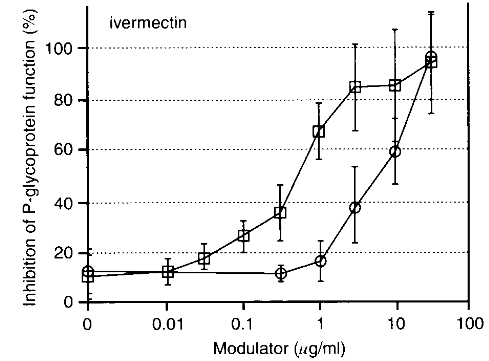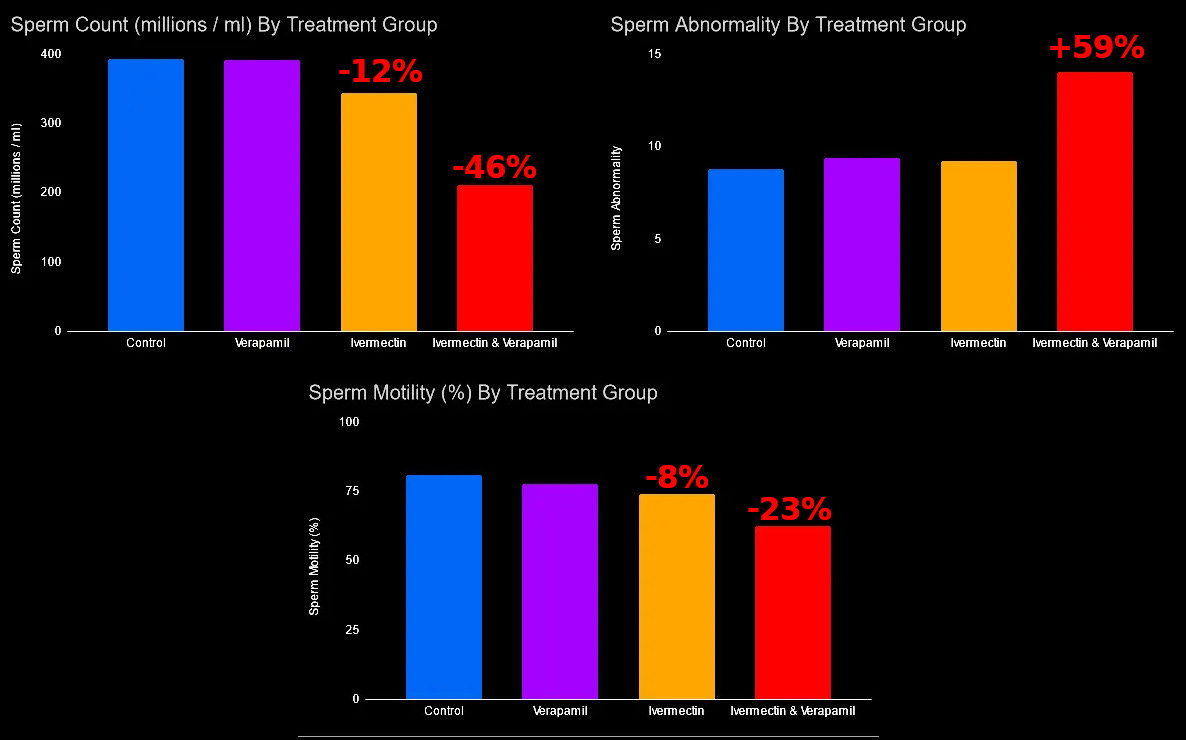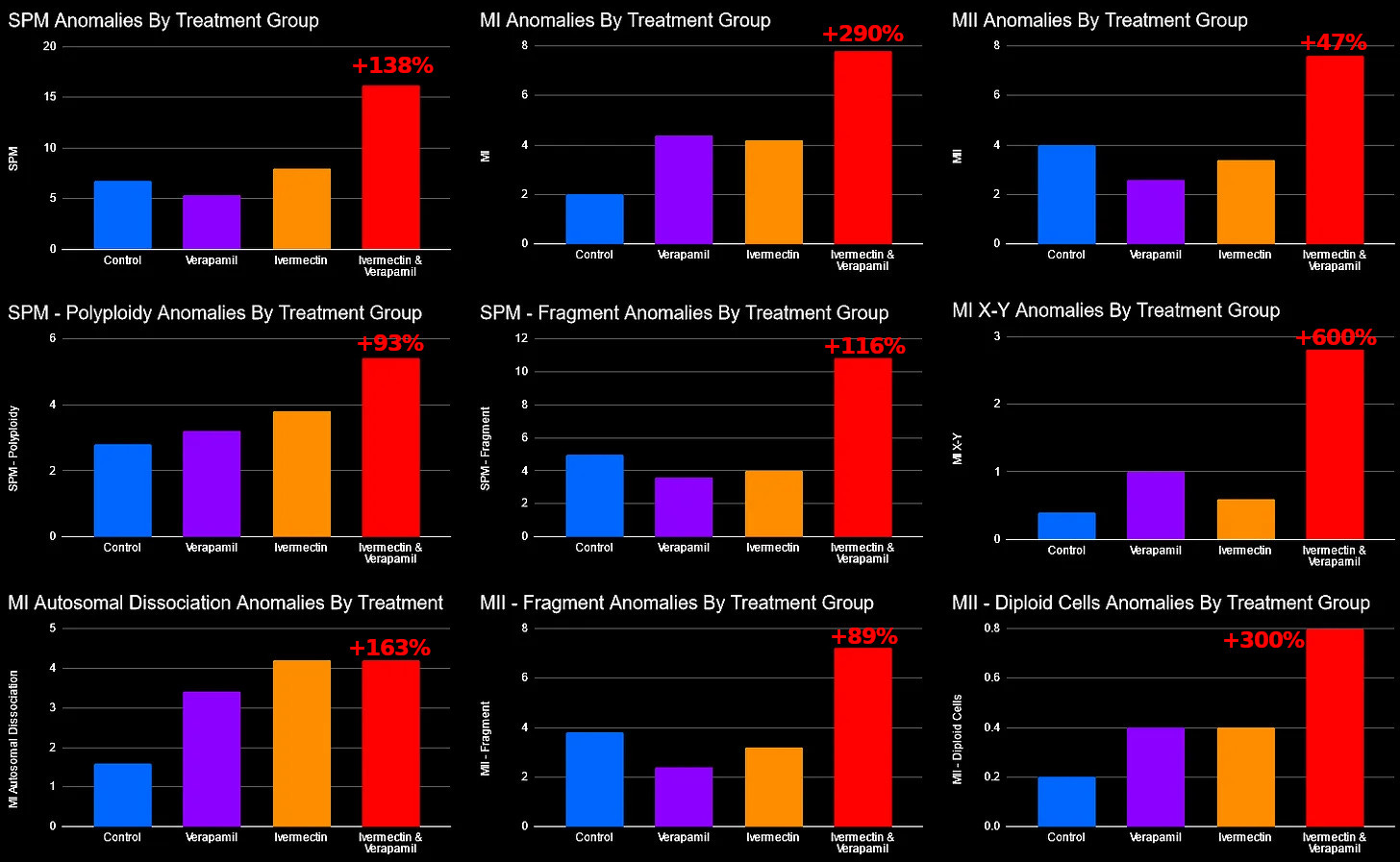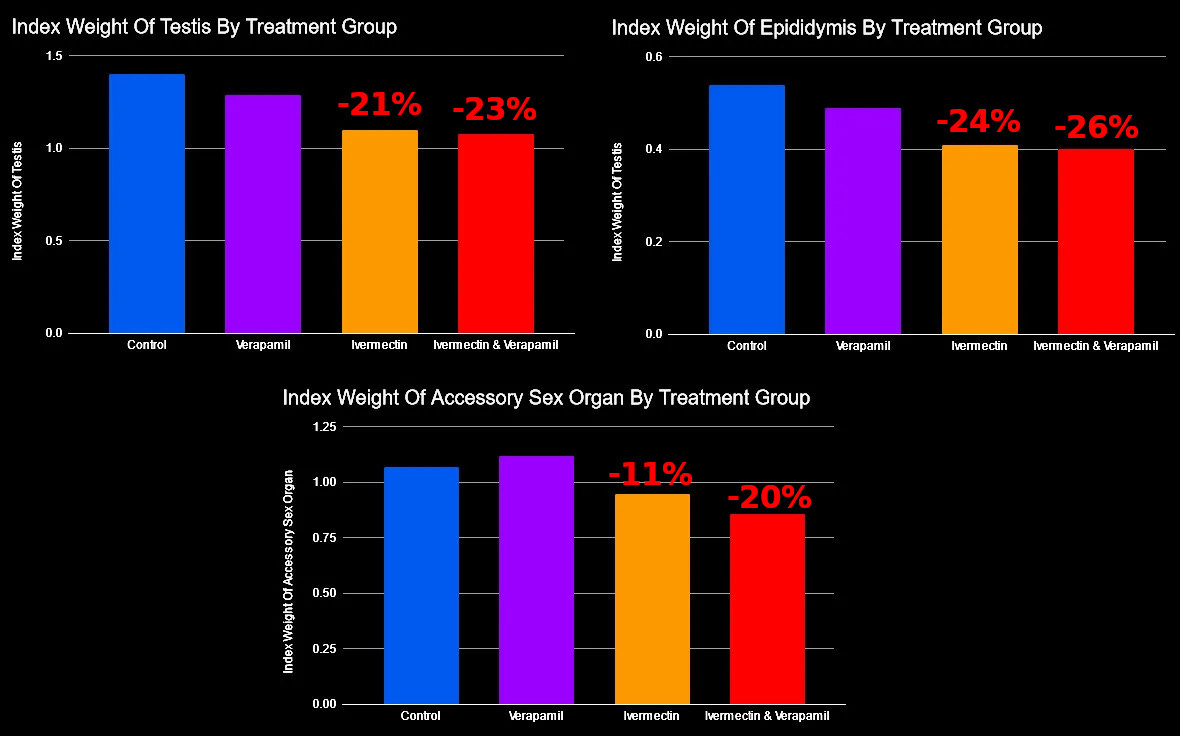P-glycoprotein Deficiency (Genetic Or Drug Induced) & Increased Ivermectin Toxicity
Many Unknowns Surround The Toxic Drug Being Pushed On The Unsuspecting Masses
Full video walkthrough now available:
Pgp Genetically Deficient Mice Have A 99% Reduced Lethal Dose Threshold of Ivermectin
In a 1994 paper called ‘Disruption of the mouse mdr1a P-glycoprotein gene leads to a deficiency in the blood-brain barrier and to increased sensitivity to drugs’ by Schinkel et al, researchers calculated the lethal dose thresholds for 2 polymorphisms of mice: mdr1a (+/+) & mdr1a (-/-) (full report):
“Mammalian P-glycoproteins are encoded by small gene families, containing two members in humans (MDR7 and MDR3) and three members in mice (mdr1a, mdr1b, and mdr2). MDR1, mdr1a, and mdr1b cDNAs can confer multi-drug resistance”
LD50 = Dosage that kills 50% of recipients
LD10 = Dosage that kills 10% of recipients
The dosage required to kill 10% of mice is 98.6% less in the mdr1a (-/-) polymorphism vs the mdr1a (+/+) polymorphism.
In argument against the 0.15 mg/kg dosage of ivermectin regularly used in Africa, the researchers noted “it is dangerously close to the lethal dose in mdr1a (-/-) mice (0.8 mg/kg).”
“The mdr1a P-glycoprotein appears to protect at at least two levels: first, it limits the amount of drug accumulating in certain tissues (brain, muscle, heart; Tables 1 and 2) and it speeds up the removal of drug from a tissue once plasma drug levels decrease (heart, kidney, liver; Table 3). Second, it enhances the rate at which drug is removed from plasma (Table 3) probably by stimulating excretion into bile and urine.”
“The plasma ivermectin level was 3-fold lower in mdr1a (+/+) than in (-/-) mice
4 hr after oral administration.”
The researchers note an earlier finding of certain collie dogs were more susceptible to ivermectin poisoning by Pulliam et al (1985)
“The lethal oral dose [of some collies] was approximately 0.4 mg/kg, as opposed to approximately 80 mg/kg in normal dogs. Hypersensitivity was associated with highly increased ivermectin accumulation in the brain (Pulliam et al., 1985). Based on this strong analogy with the mdr1a (-/-) mice, we expect these dogs to have a similar genetic deficiency in an mdr1-type P-glycoprotein.”
And it looks like they were likely correct:
Other Studies Substantiate Theory That Genetic Difference In Collies Pertaining to MDR1/ Pgp Drastically Changes IVM Toxicity
3 further studies filled in additional information regarding the MDR1/ Pgp susceptibility in collies:
a 2001 paper called ‘Ivermectin sensitivity in collies is associated with a deletion mutation of the mdr1 gene’ by Mealey et al (full report)
a 2002 paper called ‘MDR1-deficient genotype in Collie dogs hypersensitive to the P-glycoprotein substrate ivermectin’ by Roulet et al (full report)
a 2012 paper called ‘Treatment of MDR1 Mutant Dogs with Macrocyclic Lactones’ by Geyer et al
“These sensitive animals display toxic signs at doses as low as 100 μg/kg, while doses over 2000 μg/kg are required to elicit toxicity in Beagle dogs… Our results showed that the sensitive animals of our canine population were indeed homozygous for the deleted allele. Conversely, individuals of both breeds, Beagle and Collie, that were not sensitive to ivermectin displayed solely the wild-type allele” -Roulet et al
“It became absolutely clear that P-gp expression at the blood-brain barrier is the major and critical determinant for the safety margin of ivermectin and other macrocyclic lactones in mammals.” -Geyer et al
CF-1 Mice Without Pgp Expression In Intestine & Brain Endothelial Cells
In a paper called ‘Identification of a P-Glycoprotein-Deficient Subpopulation in the CF-1 Mouse Strain Using a Restriction Fragment Length Polymorphism’ by Umbenhauer et al (full report)
“There is a subpopulation of the CF-1 mouse strain that is very sensitive to the neurotoxicity induced by the avermectins… This sensitivity results from a lack of P-glycoprotein in the intestine and brain of sensitive animals, allowing increased penetration of these compounds in the blood and brain, respectively.”
“When mice of the -/-, +/-, and +/+ genotypes were treated orally with single doses of abamectin, the approximate LD50 values were 0.3, 14, and 30 mg/kg, respectively”
Here we can see the drastic difference between the testicular and brain Pgp protection for the three rats mdr1a genotypes.
Another Study With CF-1 (Genetically Deficient In Pgp) Mice
In a study called ‘P-glycoprotein deficiency in a subpopulation of CF-1 mice enhances avermectin-induced neurotoxicity’ by Lankas et al (full report)
List of P-glycoprotein Inhibitors
There are a huge number of drugs that inhibit P-glycoprotein which might make humans much more susceptible to ivermectin poisoning.
A long list of 332 P-glycoprotein inhibitors can be found on this page: https://go.drugbank.com/categories/DBCAT002667
Ivermectin, Chloroquine & Hydroxychloroquine, Quercetin are all P-glycoprotein inhibitors. Numerous statin products are Pgp inhibitors as well.
Ivermectin Itself Is A Pgp Inhibitor
According to a paper called ‘The abamectin derivative ivermectin is a potent P-glycoprotein inhibitor’ by Didier et al (full report):
“Ivermectin was itself a potent inhibitor of Pgp function; thus the ivermectin toxicity found in SDZ PSC 833-treated mice might actually result from the cumulative inhibitory effects of ivermectin and SDZ PSC 833 on the Pgp molecules, rather than their inhibition by the latter only”
“After in vivo treatment with SDZ PSC 833, mice showed a decreased tolerability to cyclsporin A (CsA), but also to ivermectin… The sequels were suggestive of CsA- or ivermectin-induced central nervous system dysfunction.. interpreted as caused by the neutralization of the Pgp at the blood-brain barrier level”
“Acute susceptibility to Ivomec-mediated toxicity was found in animals with a specific BBB deficiency such as mdr1a-knockout mice, as well as in normal mice that had been pretreated with the potent Pgp-blockers SDZ PSC 833 or SDZ 280-446”
Here’s a chart from the paper showing ivermectin administration resulting in the inhibition of P-glycoprotein function:
“Dose dependence of Pgp function inhibition by ivermectin. 1 μg/ml = 1.14 μM for ivermectin. The inhibition of Pgp function in the MDR-CEM cells is shown.. as a percentage of the Pgp probe retention (squares for DAU and circles for R-123) in similarly treated Par-CEM cells”
In a study called ‘Rapid Assessment of P-Glycoprotein Inhibition and Induction in Vitro’ by Perloff et al, researchers compared the increase to RH123 accumulation for numerous substances. Ivermectin topped the list with a massive +860% jump in the accumulation of the toxic Pgp substrate RH123. (full report)
Mouse Study Examining Altered Fertility Post-Ivermectin & With Pgp Inhibitor
In a study called ‘Effect of ivermectin on male fertility and its interaction with P-glycoprotein inhibitor (verapamil) in rats’ by El-Nahas & El-Ashmawy (full report)
There is a sizeable 12% reduction in sperm count after ivermectin of 343.3 million sperm per ml compared to the 392.3 million sperm per ml in the No-Ivermectin control group. There is an even more profound 46% reduction when the ivermectin is paired with a Pgp inhibitor.
The abnormal sperm rockets up 59% with Ivermectin and a Pgp-inhibitor,
Sperm motility drops 8% with Ivermectin and 23% with Ivermectin paired with Pgp-inhibitor
When paired with Pgp inhibiting verapamil, a drug for high blood pressure/ chest pain, the effects of the Ivermectin are much more deleterious to the male fertility metrics. The paper notes this may be because verapamil serves as a Pgp blocker.
“The low ivermectin toxicity has attributed to its restricted access to some tissues, especially for being a substrate of Pgp. Pgp is linked to the integrity of blood–tissue
barriers, such as the blood–brain barrier, testis or placenta and a partial blockade of Pgp could be responsible for a new drug distribution in the organism with possible increases of drug rates in organs behind these barriers. Therefore, concomitant administration of substrates and Pgp inhibitors would modify drug pharmacokinetics by increased bioavailability and organ uptake”
Let’s look at the differences in abnormal sperm cells by category by treatment group in this series of 9 charts:
Organ Weights
Vacuolar Degeneration
Check out the paper’s photos of “Vacuolar degeneration” in Ivermectin (1b) VS no-Ivermectin controls (1a):
The paper explains: “in case of treatment with (ivermectin + verapamil) some destructive changes were seen in the form degeneration in some tubules with presence of coagulated luminal contents in some seminiferous tubules, in addition to complete coagulative necrosis of some other tubules (Fig. 1c and d).”
Smaller Lethal Ivermectin Doses & More Brain Accumulation For Mice with -/- Polymorphism For Mdr1ab Gene
In a paper called ‘Relative Neurotoxicity of Ivermectin and Moxidectin in Mdr1ab (-/-) Mice and Effects on Mammalian GABA(A) Channel Activity’ by Ménez et al (full report)
Note how much higher the brain concentration of ivermectin reaches in the -/- MDR1ab polymorphism, even at much smaller doses. This massive difference is likewise reflected in the lethal dose required to kill 50% of the population by mdr1ab polymorphism:
Do Humans Have A Similar Polymorphism To Ivermectin Sensitive Rats & Dogs?
In a study called ‘Possible pathogenic pathways in the adverse clinical events seen following ivermectin administration to onchocerciasis patients’ by Mackenzie et al, researchers examined why so many ivermectin recipients landed in a coma and some even died. In addition to the idea than some people have a less intact blood brain barrier, researchers add it’s possible that some people have less Pgp protection due to genetic differences:
“It would not be surprising to find that loss-of-function mdr1a mutations exist in humans, as they do in dogs. There is no evident phenotype for the mutation in dogs other than acute sensitivity to ivermectin and a few other drugs. It would also not be surprising to find that such a mutation would be geographically restricted [40], found perhaps at a detectable frequency in one or a few populations exposed to ivermectin (a rare event in wealthy countries). Indeed, one might almost predict the eventual appearance of ivermectin toxicity in a human population from an analysis of the situation observed in canines.”
How many comas and deaths have been caused by ivermectin treatment? The researchers found that:
To date, 46 cases of this syndrome have been recorded, with 22 fatalities. The condition has probably been under-reported, with possibly up to 80 fatalities out of ~300 cases of the syndrome actually having occurred in Cameroon
Human Populations With MDR1 Gene Mutations Limiting P-glycoproteins
According to various studies (see below screen shot), certain ethnicities are much more prone to a TT MDR1 gene exon 26 C3435T mutation:
So how large of a difference is the Pgp between these groups?
TT Polymorphism Has More Than A Two-Fold Lower PGP Expression
In a study called ‘The C3435T mutation in the human MDR1 gene is associated with altered efflux of the P-glycoprotein substrate rhodamine 123 from CD56+ natural killer cells’ by Hitzl et al:
“Carriers homozygous for this polymorphism (TT) showed more than two-fold lower PGP expression… compared to the CC group”
How does this compare to the Pgp-inhibitor Verapamil examined earlier?
Verapamil Resulted In 3-fold Decrease in Pgp Expression
In a study called ‘Verapamil decreases P-glycoprotein expression in multidrug-resistant human leukemic cell lines’ by Muller et al (full report): “In the K562/ADR cell line, addition of verapamil to the culture medium (15 microM concentration) resulted in a 3-fold decrease in Pgp expression after 72 hr exposure.”
Severe Ivermectin Toxicity for Boy With ABCB1 Mutation
In a paper called ‘Serious Ivermectin Toxicity and Human ABCB1 Nonsense Mutations’ a case study is examined by which a 13 year old boy was sent to the hospital in a coma after just one ivermectin pill.
The boy experienced “impaired consciousness”:
“His condition worsened 6 hours after he received ivermectin, with persistent neurologic signs, including coma, ataxia, pyramidal signs, and binocular diplopia, as well as abdominal pain and vomiting.”
Researchers determined that the boy was way more susceptible to ivermectin poisoning his brain because he had a mutation that resulted in low protection:
“ABCB1 sequencing identified the child as a compound heterozygote for two nonsense mutations… The loss of ABCB1 activity in the child would have resulted in a failure of brain protection and probably would have induced high exposure of the central nervous system to ivermectin and the toxic effects observed.”
ABCB1-1Δ Polymorphism & Pgp’s Role Of Protecting Dogs’ Brains
In a paper called ‘Toxicology of Avermectins and Milbemycins (Macrocylic Lactones) and the Role of P-Glycoprotein in Dogs and Cats’ by Merola and Eubig
“In dogs with this [ABCB1-1Δ] defect, treatment with doses of MLs above those used for heartworm prevention may result in accumulation of the drug in the CNS, resulting in neurologic effects. Adverse neurologic effects can also occur in animals without the gene defect when overdoses of MLs are administered, in which case saturation of the transport capacity of P-gp likely occurs.”
Toxic Ivermectin Dosages for ML Sensitive Dogs (mg/kg): 0.1–0.4 Orally or 0.2–0.25 Subcutaneously
“Clinical signs have developed following oral dosages as low as 0.1 mg/kg in ivermectin-sensitive collies. In overdoses, the most frequent clinical signs reported in dogs were lethargy, ataxia, hypersalivation, tremors, mydriasis, blindness, and bradycardia.22,26 Coma, seizures, and death have been seen in severely affected animals.”
“In dogs, it takes about 4 hours for orally administered ivermectin to reach maximum plasma levels”
Pig Study With Pgp Inhibition & Ivermectin
Let’s look at another study showing enhanced pharmakokinetics of ivermectin paired with a Pgp inhibitor called ketoconazole. In the first part of the study we examined how the Pgp-inhibitor ketoconazole affected absorbption of ivermectin into cerebrospinal fluid and plasma of pigs. (Link to full paper)
“Pre-treatment with ketoconazole significantly increased the time above LC50 3-fold from a median of 36 to 111 hours (P = 0.033). The Cmax was also increased 2-fold (median 14 vs 28 ng/ml, P = 0.033), along with a more than 3-fold increase in the AUC > LC50 (median 212 vs 711, P = 0.033). The total AUC was also increased more than 2-fold (862 vs 2092 h*ng/ml)”
This study is based on the barbaric idea of dosing animals or humans with ivermectin to turn their blood deadly to mosquitoes. So in the paper when they talk about LC50 that means the plasma ivermectin concentration that is lethal for 50% of mosquitoes that bite the poisoned pig.
Perhaps of greater concern is one of the pigs dosed with ivermectin died before they could measure the response: “Pig 72 died and was replaced by pig 75”
Pgp-Inhibiting Agents & Increased Ivermectin Neurotoxicity
In a paper called ‘Cyclosporin A and trifluoperazine, two resistance-modulating agents, increase ivermectin neurotoxicity in mice’ ersearchers explored the increased toxicity of ivermectin when paired with Pgp inhibitors cyclosporin A and trifluoperazine (full report)
“When mice received an injection of cyclosporin A (50 mg/kg. intraperitoneally) or trifluoperazine (750 pg/kg, intraperitoneally) one hour prior to the administration of ivermectin (10- 15 mgikg, intraperitoneally) there was an increase in the acute toxicity of ivermectin”
“HPLC analysis of brain tissues indicated that the ivermectin brain concentration was 2.5 times higher when mice were previously treated with cyclosporin A (50 mg/kg).”
“Ivermectin acute toxicity is illustrated in fig. I , and LD50 was estimated at 14-15 mg/kg”
“Animals presented many symptoms characteristic of ivermectin toxicity including loss of balance, tremors and immobilization that progressed to comatose state and subsequently death (Schinkel et al. 1994)”
“Some animals injected with doses between 10-16 mg/kg showed some of the intoxication symptoms without progressing into comatose state”
“Mice that died after treatment with 10-20 mg/kg ivermectin died during the first 24-72 hr after the drug administration, whereas those receiving doses higher than 20 mg/kg died during the first 24 hr.”
“A mortality of 100% was observed in the first 18 hr after the administration of 50 mg/kg cyclosporin A plus 10 mg/kg ivermectin”
Other key findings from the study:
0 mg/kg cyclosporin A plus 10 mg/kg ivermectin had a 14% mortality rate
10 mg/kg cyclosporin A plus 10 mg/kg ivermectin had a 16.7% mortality rate
25 mg/kg cyclosporin A plus 10 mg/kg ivermectin had a 65.4% mortality rate
50 mg/kg cyclosporin A plus 1 mg/kg ivermectin had a 34.6% mortality rate
Another Study Using Pgp Inhibitor To Increase Ivermectin Exposure
In a study called ‘Multiple oral dosing of ketoconazole increases dog exposure to ivermectin’ by Hugnet et al (full report) researchers used the Pgp/ Cyp3A4 inhibitor ketoconazole at clinical dosing to measure the increased toxicity of ivermectin
“Co-administered ketoconazole induced a higher plasma concentration and longer residence time of ivermectin in dogs, leading to a substantial increase in the overall exposure of the animal to the drug”
“Multiple oral dosing of ketoconazole dramatically altered the pharmacokinetics of ivermectin in dogs leading to an increase in systemic exposure to the drug. Neurotoxicity of ivermectin means that inhibition of the P-gp function at the blood-brain barrier during polytherapy using P-gp inhibitors must be taken into consideration.”
“Concomitant administration of ketoconazole induced substantial increases in plasma concentrations of ivermectin resulting in a significant increase in the AUC (2-fold, p<0.001).”
Relation of ABCB1 Gene And Toxicity In Fall Armyworms
In a paper called ‘Knockout of the ABCB1 Gene Increases Susceptibility to Emamectin Benzoate, Beta-Cypermethrin and Chlorantraniliprole in Spodoptera frugiperda’ by Li et al:
“Knock out of ABCB1 gene in Spodoptera exigua resulted in three times the sensitivity to abamectin and emamectin benzoate”
According to PubChem: “Emamectin benzoate is the 4'-deoxy-4'-epi-methyl-amino benzoate salt of avermectin B1 (abamectin)”
Relation of P-glycoprotein Genetic Deficiency & Abamectin Toxicity In Beet Armyworms
In another similar paper called ‘Knockout of a P-glycoprotein gene increases susceptibility to abamectin and emamectin benzoate in Spodoptera exigua’ by Zuo (full report) researchers studied a P-glycoprotein knockout strain of Spodoptera exigua (Beet Armyworms) called Spodoptera exigua P-glycoprotein that has less expression of P-glycoprotein.
For Abamectin, the relative Lethal Concentration 50% for normal larvae and P-glycoprotein knockout armyworm larvae were 0.3 µg/cm^2 & 0.11 µg/cm^2 respectively.
For Emamectin benzoate, the relative Lethal Concentration 50% for normal larvae and P-glycoprotein knockout armyworm larvae were 0.0017 µg/cm^2 & 0.00055 µg/cm^2 respectively.
Lethal Concentration 50% = the dosage by which 50% of the larvae died.
In other words, it takes 63% less abamecin to kill 50% of the P-glycoprotein knockout armyworm alrvae. Likewise, it takes 67% less Emamectin benzoate to kill 50% of the P-glycoprotein knockout armyworm alrvae.
Pgp And Avermectin Resistance in the Diamondback Moth
In a paper called ‘Molecular Cloning and Characterization of a P-Glycoprotein from the Diamondback Moth, Plutella xylostella’ by Zuo et al, the researchers
“Pgp has been implicated in avermectin resistance in a number of parasites and insects [37–40]. Moreover, overexpression of Pgp has been documented in the resistant strains of several insect species, including the spider mite, Tetranychus urticae, the salmon louse, Lepeophtheirus salmonis, the tobacco budworm, Heliothis virescens, and the cotton bollworm, Helicoverpa armigera, which is consistent with the drug-resistant nematodes”
P. xylostella larvae were dosed with abamectin at a concentration of LC50 of 25 μg/L:
“Exposure to abamectin, a macrocyclic lactone derivative with potent anthelmintic and insecticidal properties, significantly induced the expression of PxPgp1 in P. xylostella, implicating the involvement of PxPgp1 in the acute response to insecticide treatment. More importantly, the constitutive overexpression of PxPgp1 in the abamectin-resistant P. xylostella suggests the potential connection of PxPgp1 and abamectin resistance.”
There appears to be a correlation between Pgp expression and how well a given strain can resist abamectin:
Abamectin Toxicity For Farm Dogs Without ABCB1 Gene Mutation
In a paper called ‘Macrocyclic lactone toxicity due to abamectin in farm dogs without the ABCB1 gene mutation’ (full report) researchers clarify that it is NOT just animals with Pgp genetic deficiencies who can experience abamectin toxicity. They present 2 case reports for dogs without the ABCB1 mutation who still experienced Abamectin poisoning.
More Resources:
Looking for more information on the dangers of ivermectin? Check out this playlist:
Other Substack articles in this Ivermectin series:































Not sure if this is the place to ask this question but how did ivermectin go from being the answer for anti covid vax people and being a Nobel prize wonder drug to this?
I work in fertility and am concerned with the levels of LH, FSH and TSH that I'm seeing in the clinic, especially the past 3 years. Since these 3 hormones are glycoproteins, I wonder if you know if they have some protective involvement with keeping toxins out of the thyroid, ovaries and testes? I have always thought of them as signalling hormones and to to think of other purposes over and above the signalling aspect is interesting.